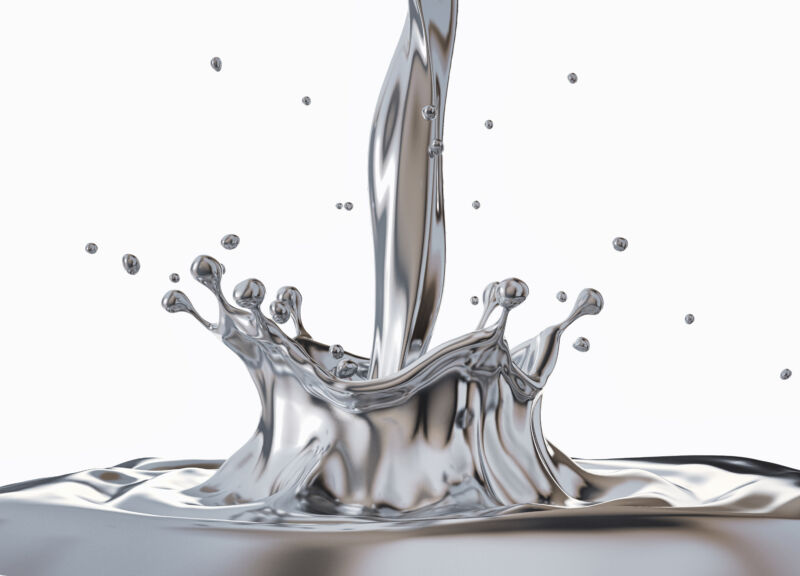While paper isn’t exactly a smart material, it someday could be if it is covered in a new type of liquid metal. This liquid alloy has the potential to turn paper and other materials into gadgets that can do some things on their own.
Liquid metal is already used in smart objects like circuits and wearable sensors—but not as a coating. Inspired by origami, a team of scientists led by Bo Yuan of Tsinghua University in China has figured out a way to formulate liquid metal and apply it with a stamp so it sticks to paper without an adhesive, which has never been possible before. In a study recently published in Cell Reports Physical Science, the scientists showed that paper coated in the metal can be crafted into origami shapes and re-fold itself. The metal coating also conducts heat and electricity. It’s like magic. Almost.
A sticky alloy
Because the particles in liquid metal tend to stay so close together, it is difficult to get it to adhere to any surface without something that acts as glue. But these adhesives usually have a negative effect on the metal’s properties, such as its conductivity. Yuan and his team wanted a liquid metal that could stick to paper without an adhesive. They used an alloy of bismuth, indium, and tin oxide (BiInSn) and tested how well it performed next to an indium/gallium alloy (eGaIn).
BiInSn turned out to be more effective. Unlike eGaIn, it doesn’t oxidize when exposed to air, so how well it sticks to a surface does not depend on the oxide film that forms on the metal. BiInSn is a solid at room temperature and has a higher melting point, so there is no risk of it liquefying at temperatures under 62° Celsius (about 144° Fahrenheit). It is also capable of stronger adhesion. However, getting optimal adhesion out of BiInSn required trial and error.
“We needed to ensure the adhesion of liquid metal to be uniform in large scale on different paper, and to maintain the stability of the coating,” Yuan told Ars Technica in an email interview. “To solve these problems, we changed pressure applied on the stamp as well as the rubbing speed used in the experiments and finally found the most suitable parameters, which finally achieved fast, large-scale, and stable adhesion.”
The researchers tried stamping it onto paper with different amounts of pressure and found out that not much is needed for it to stay in place. They then created an origami cube out of the metal-coated paper, which required the edges to adhere to each other without any other binding agent. They even saw that when that square was unfolded, the coated paper could fold itself back into its original shape. Because the metal coating was self-adhesive, the edges that had been unfolded attracted each other until the paper became a cube again. Another shape they tried was a spring that could be stretched or compressed and would remain however it was adjusted.
It was also possible for the team to build 3D structures out of individual pieces of flat, metal-coated paper. These structures could keep their shape without falling apart, and the coating could just be peeled off afterward without affecting the properties of its paper substrate in any way. The coating, which also lost none of its properties, could be recycled and used repeatedly. The paper just went back to being paper.
Next steps
Yuan thinks self-adhesion through liquid metal is an advantage, because, if it can be done with paper, it could be done with other thin, lightweight materials to create smart objects and soft robots that can fit into tight spaces. The next thing he wants to accomplish is finding a coating where the metal does not peel off once solidified. He is considering testing bio-friendly paint spray to protect the coating in materials that may eventually be used as packaging (boxes could open and close themselves just like the paper cube in the experiment), on human skin (bandages would come off painlessly without glue), underwater, and even in conditions seen on other planets and moons.
This substance could possibly be an asset to soft robots in alien environments. Some soft robots can already explore the deepest reaches of the ocean where the pressure is too high for humans and the cracks and crevices too small for larger machines. Soft robots are being designed with an eye for subsurface tunnels on Mars and other bodies in space. Autonomous soft robots that are thin and flexible would be able to venture into places where larger rovers are unable to fit or navigate safely, and the self-adhesion of the liquid metal coating would allow them to fold and unfold on their own.
“Utilizing our method, one can quickly create smart materials with good thermal and electrical conductivity as well as stiffness-tunable ability, which greatly expands material options for soft robots,” Yuan said in the interview. “I think that this method may provide a new route for designing space explorers."
Cell Reports Physical Science, 2023. DOI: 10.1016/j.xcrp.2023.101419 (About DOIs).



3175x175(CURRENT).thumb.jpg.b05acc060982b36f5891ba728e6d953c.jpg)
Recommended Comments
There are no comments to display.
Join the conversation
You can post now and register later. If you have an account, sign in now to post with your account.
Note: Your post will require moderator approval before it will be visible.